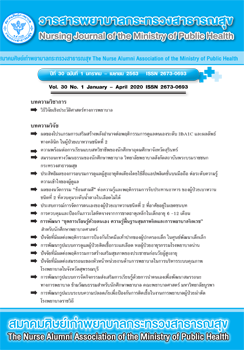Control and Prevention of Iron Deficiency Anemia in Children Aged 6 -12 Months
Main Article Content
Abstract
This research aimed to 1) study the situation of anemia in children aged from 6 to 12 months, and 2) compare hemoglobin levels before and after implementation of an iron supplementation program . The sample consisted of 566 children, both male and female, age 6-12 months and 566 parents, who came to the well-baby clinic in 2018. The sample was divided into experimental and control groups, with 283 children in each group. These children were clients of the health promotion hospitals in region 5, in 2018. The program includes blood tests, evaluation of anemic condition and the administration of iron supplements. The instrument used for collecting data were a parent interview form and blood hemoglobin test. Data analysis included descriptive statistics and t-tests. The results found that children aged 6 and 9 months had an anemia rate of 16.9 % and 23.3 %, respectively. When taking iron supplements, the rate of anemia decreased to 13.4 % and 18.5 %, respectively. The parent’s knowledge of the intake of iron supplements was at a moderate level. The results from this study can be applied to adjust the policies of anemia screening system in well-baby clinics, and the development guidelines and advanced warning technologies such as mobile phone alerts to parents or the use of multimedia to give information.
Article Details
บทความและรายงานวิจัยในวารสารพยาบาลกระทรวงสาธารณสุข เป็นความคิดเห็นของ ผู้เขียน มิใช่ของคณะผู้จัดทำ และมิใช่ความรับผิดชอบของสมาคมศิษย์เก่าพยาบาลกระทรวงสาธารณสุข ซึ่งสามารถนำไปอ้างอิงได้
References
2. World Health Organization. Iron Deficiency Anemia Assessment, Prevention and Control A guide for programme managers. Geneva: World Health Organization. 2001.
3. Prateep M, Chongsuwat R, Saliphan S, Lertlakanawong P. Thailand food and nutrition survey report No. 5, 2006. Nonthaburi: Division of Nutrition, Department of Health, Ministry of Public Health. 2006. (in Thai)
4. Susantitaphong P. Hemoglobin, embryonic red blood cell to help diagnose iron deficiency in Healthy children aged between 6 months to 2 years old. [Thesis certificate showing expertise in Practice medicine Pediatrics]. Bangkok: Chulalongkorn University. 2011. (in Thai)
5. Sookdee J, Wanaratwichit C. Factors affecting iron deficiency anemia among pregnant women receiving antenatal care at sub-districts health promoting hospital. Journal of Health Science Research 2016;10(1):1-7. (in Thai)
6. Viriyautsahakul N. Guidelines for control and prevention of iron deficiency anemia. Nonthaburi: Bureau of Nutrition, Department of Health, Ministry of Public Health; 2013. (in Thai)
7. Deejuthamanee R, Moonrattana A, Arunakul J, Poyam W, Empremsilapa S. Effectiveness of weekly iron supplementation to prevent iron deficiency anemia in secondary school students. VAJIRA NURSING JOURNAL 2018;20(2):13-21. (in Thai)
8. Mongkhonporn W. Situation and results of treatment for anemia in good child health clinic- hospital. Promote health. Health Center 5 Nakhon Ratchasima 2013:15-33. (in Thai).
9. R. Colin C., Joseph L. J., Matthew J. et al. (2010). Iron deficiency anemia and cognitive function in infancy. Pediatrics 2010;126(2):427-434. (in Thai)
10. Tantrachewathorn S, Lohajaroensub S, Incidence and risk factor of iron deficiency anemia in term infants. J Med ASSOC Thai 2005;88(1): 44-51. (in Thai)
11. Leandre R. Fabrigar, Tara K. MacDonald, Duane T. Wegener. The Structure of Attitudes from: The Handbook of Attitudes. [internet]. 2019 [cited 2019 May 20] Available: https://www.routledgehandbooks.com/doi/10.4324/9781410612823.ch3

